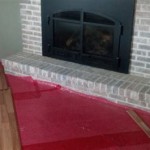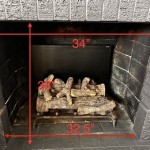Thermostat Control for Gas Fireplaces: Functionality and Considerations
Gas fireplaces offer a convenient and aesthetically pleasing alternative to traditional wood-burning fireplaces. A key advantage of gas fireplaces is the potential for precise temperature control, often achieved through the integration of a thermostat. Understanding how thermostats function with gas fireplaces, the various types available, and the factors to consider when selecting one is crucial for maximizing comfort and efficiency.
The primary function of a thermostat in a gas fireplace system is to regulate the gas flow to the burner based on the ambient temperature. This allows for automated temperature maintenance, preventing the fireplace from continuously emitting heat and potentially overheating the room. The thermostat acts as a sensor and controller, constantly monitoring the room temperature and adjusting the gas supply to maintain a pre-set level.
Without a thermostat, a gas fireplace would typically operate at a fixed output level until manually adjusted or switched off. This can lead to inconsistent heating and wasted energy. A thermostat, therefore, provides a significant improvement in terms of both comfort and energy efficiency.
The location of the thermostat is also crucial for accurate temperature regulation. It should be positioned in a representative area of the room, away from drafts, direct sunlight, or other heat sources that could skew its readings. Incorrect placement can lead to the fireplace cycling on and off unnecessarily or failing to maintain the desired temperature.
Types of Thermostats for Gas Fireplaces
Several types of thermostats are available for use with gas fireplaces, each offering different features and levels of control. The choice of thermostat depends on factors such as budget, desired features, and compatibility with the specific gas fireplace model.
Millivolt Thermostats: These are the most common and often the simplest type of thermostat used with gas fireplaces. They operate on a very low voltage, typically generated by the thermocouple (or thermopile) of the gas fireplace itself. This eliminates the need for external power sources like batteries or AC power. Millivolt thermostats are typically mechanical or electromechanical, using a bi-metallic strip or a simple electrical circuit to sense temperature and control the gas valve.
The simplicity of millivolt thermostats makes them reliable and relatively inexpensive. However, they generally offer less precise temperature control compared to electronic thermostats and may lack advanced features such as programmable schedules or remote control capabilities. They are primarily suited for basic on/off control of the fireplace based on a set temperature.
Electronic Thermostats: These thermostats require an external power source, either batteries or a hardwired connection to the home's electrical system. They use electronic sensors and circuitry to measure temperature and control the gas valve. This allows for more precise temperature control and the implementation of advanced features.
Electronic thermostats often feature digital displays, programmable schedules, and remote control capabilities. Some models can even be integrated with smart home systems, allowing for control via smartphone apps or voice commands. The increased functionality comes at a higher cost compared to millivolt thermostats, and the reliance on a power source adds a potential point of failure.
Remote Control Thermostats: These thermostats combine the functionality of a standard thermostat with the convenience of remote control. They typically consist of a thermostat unit that controls the gas valve and a handheld remote control that allows the user to adjust the temperature, turn the fireplace on or off, and access other features from a distance.
Remote control thermostats can be either millivolt or electronic. Electronic models offer more advanced features, such as programmable schedules and temperature displays on the remote control itself. Remote control functionality is particularly useful for those who have mobility issues or who simply prefer the convenience of adjusting the fireplace settings without having to approach the unit.
Smart Thermostats: These are the most advanced type of thermostat available for gas fireplaces. They connect to a home's Wi-Fi network and can be controlled remotely via a smartphone app or web interface. Smart thermostats learn user preferences and can automatically adjust the temperature based on schedules, occupancy, and even weather conditions.
Smart thermostats offer the most comprehensive level of control and energy efficiency. They can be integrated with other smart home devices, such as lighting and security systems, to create a fully automated home environment. However, they are also the most expensive type of thermostat and require a stable Wi-Fi connection to function properly. The initial setup can also be more complex compared to traditional thermostats.
Factors to Consider When Choosing a Thermostat
Selecting the right thermostat for a gas fireplace involves considering several factors, including compatibility, features, and budget. A thorough assessment of these factors will help ensure that the chosen thermostat meets the specific needs and preferences of the user.
Compatibility: The most crucial factor is compatibility with the gas fireplace itself. Not all thermostats are compatible with all gas fireplace models. It is essential to consult the fireplace's owner's manual or contact the manufacturer to determine the correct type of thermostat for the unit. Using an incompatible thermostat can damage the fireplace or render it inoperable.
Specifically, understanding whether the fireplace operates on a millivolt system is paramount. Attempting to connect a thermostat requiring external power to a millivolt system will not work and can potentially damage the millivolt circuit. Similarly, connecting a millivolt thermostat to a system requiring powered switching can also lead to damage. Therefore, confirming compatibility before purchasing is of utmost importance.
Desired Features: The features offered by different thermostats vary widely. Consider the features that are most important, such as programmability, remote control, smart home integration, and temperature display. Programmable thermostats allow for setting different temperatures for different times of the day, which can save energy. Remote control provides convenience, while smart home integration allows for seamless control of the fireplace from anywhere with an internet connection.
If precise temperature control is desired, an electronic thermostat is generally preferred over a millivolt thermostat. For users who prioritize simplicity and reliability, a basic millivolt thermostat may be sufficient. The selection should be based on a careful assessment of the user's needs and preferences.
Budget: The price of thermostats for gas fireplaces can range from relatively inexpensive millivolt models to more expensive smart thermostats. Establish a budget before starting the selection process and consider the long-term benefits of investing in a more advanced thermostat. While a smart thermostat may have a higher initial cost, its energy-saving features can potentially offset the cost over time.
Consider the installation costs as well. While some thermostats are easy to install, others may require professional installation, particularly if wiring modifications are necessary. Factor in these costs when comparing different thermostat models.
Installation and Maintenance Considerations
The installation and maintenance of a gas fireplace thermostat are critical for ensuring its proper functioning and longevity. While some installations are straightforward, others may require the expertise of a qualified technician. Proper maintenance is also essential for preventing problems and ensuring that the thermostat continues to operate accurately.
Installation: Before installing any thermostat, always disconnect the gas supply to the fireplace. Read the manufacturer's instructions carefully and follow them precisely. For millivolt thermostats, the installation typically involves connecting the thermostat wires to the appropriate terminals on the gas valve. For electronic thermostats, a power source must be connected, and the wiring may be more complex.
If the installation involves modifying the existing wiring or gas lines, it is strongly recommended to hire a qualified HVAC technician. Improper installation can create a safety hazard and damage the fireplace or thermostat. After installation, test the thermostat to ensure that it is functioning correctly.
Maintenance: Regular maintenance is essential for keeping the thermostat in good working condition. Dust and debris can accumulate inside the thermostat housing, affecting its accuracy. Clean the thermostat periodically with a soft cloth. Avoid using harsh chemicals or abrasive cleaners, as these can damage the thermostat's components.
For electronic thermostats, check the batteries regularly and replace them as needed. Low batteries can cause the thermostat to malfunction or stop working altogether. If the thermostat is not functioning properly, consult the owner's manual or contact a qualified technician for assistance.
Furthermore, it's advisable to perform a visual inspection of the wiring connections periodically to ensure they remain secure and free from corrosion. Loose or corroded connections can lead to unreliable operation and potential safety hazards.
By considering these factors and following proper installation and maintenance procedures, homeowners can enjoy the comfort and convenience of a thermostat-controlled gas fireplace for years to come. Choosing the right thermostat can significantly enhance the efficiency and enjoyment of a gas fireplace, providing a comfortable and inviting atmosphere while minimizing energy waste.

Skytech Ts 3 Wired Wall Mounted Thermostat Fireplace Control

Flameworks Gas Fireplace Thermostat Non Programmable Vertical Mount Fire Parts Ca

How To Connect A Nest Thermostat Gas Fireplace Ohmefficient

Flameworks Gas Fireplace Thermostat Non Programmable Vertical Mount Fire Parts Ca

Wifi Fireplace Wall Thermostat Friendly Fires

Wireless Remote Thermostat For Gas Fireplace

Everwarm Thermostat Rermote Control For Gas Logs Fine S

Gas Fireplace Wall Thermostat B C Comfort Hvac Repair Installation

How To Connect A Nest Thermostat Gas Fireplace Ohmefficient

Heat N Glo Multi Functional Wall Control Fine S Gas
Related Posts








